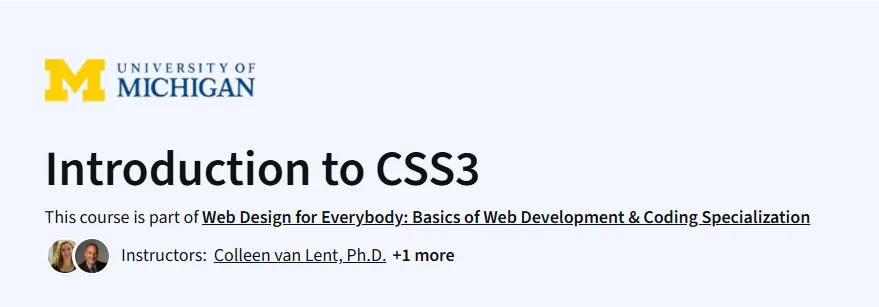What will you learn in Introduction to CSS3 Course
- Understand the importance of separating content from presentation in web pages.
- Write basic CSS rules to modify colors, fonts, and text properties.
- Manipulate layout and spacing using the box model, width, height, and line-height.
- Apply advanced selectors, pseudo-classes, and pseudo-elements for dynamic styling.
- Ensure accessibility by evaluating pages with POUR guidelines.
Program Overview
Module 1: Getting Started with Simple Styling
⌛ ~4 hours
- Topics: Course welcome, CSS syntax, selectors, color properties, font styling.
- Hands-on: Write CSS rules to style headings, paragraphs, and links on a sample HTML page.
Module 2: Box Model, Layout, and Typography
⌛ ~4 hours
- Topics: Box model fundamentals (margin, border, padding), width/height, text properties, line-height.
- Hands-on: Adjust layout and text appearance on an existing page using box-model properties.
Module 3: Advanced Selectors and Dynamic Effects
⌛ ~4 hours
- Topics: Attribute selectors, pseudo-classes (hover, focus), pseudo-elements (::before, ::after), transitions.
- Hands-on: Add hover effects and smooth transitions to navigation menus and buttons.
Module 4: Responsive Design and Accessibility
⌛ ~4 hours
- Topics: Media queries basics, browser compatibility, POUR accessibility guidelines.
- Hands-on: Implement a responsive layout and evaluate it for accessibility compliance.
Module 5: Capstone Project – Complete CSS Page
⌛ ~4 hours
- Topics: Integrating CSS concepts, debugging best practices, maintainability strategies.
- Hands-on: Sketch a design for a provided HTML template and use CSS to fully realize the mockup.
Get certificate
Job Outlook
- Strong demand for front-end developers and web designers with solid CSS skills.
- Roles such as Front-End Developer, UI/UX Designer, and Web Accessibility Specialist rely on CSS3 expertise.
- Mastery of responsive design and accessibility increases employability across tech companies and agencies.
Specification: Introduction to CSS3
|
FAQs
- Some prior HTML familiarity recommended but not strictly required.
- Focuses on styling, layout, and accessible web design.
- Includes hands-on exercises with sample HTML templates.
- Ideal for beginners aiming to become front-end developers or web designers.
- Teaches core CSS3 concepts step-by-step for practical application.
- Covers font styling, text properties, and color rules.
- Teaches layout adjustments using the box model, width, height, and spacing.
- Includes exercises to style headings, paragraphs, and links.
- Focuses on improving readability and visual appeal.
- Prepares learners for creating visually polished web pages.
- Teaches media queries for responsive layouts.
- Covers browser compatibility and accessibility using POUR guidelines.
- Includes exercises to evaluate and adjust pages for accessibility.
- Skills improve employability as a front-end or UI/UX developer.
- Prepares learners to create inclusive and mobile-friendly web pages.
- Duration: approximately 20 hours, divided into five 4-hour modules.
- Self-paced learning allows flexible scheduling.
- Modules cover simple styling, box model, advanced selectors, responsiveness, and a capstone project.
- Hands-on exercises reinforce every concept progressively.
- Suitable for learners seeking structured and immersive CSS3 training.
- Covers attribute selectors, pseudo-classes like hover and focus, and pseudo-elements (::before, ::after).
- Teaches adding smooth transitions and dynamic effects.
- Includes exercises to enhance navigation menus and buttons.
- Prepares learners for creating interactive and visually engaging web pages.
- Skills directly transferable to professional front-end development projects.





